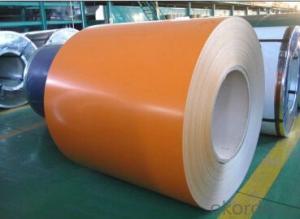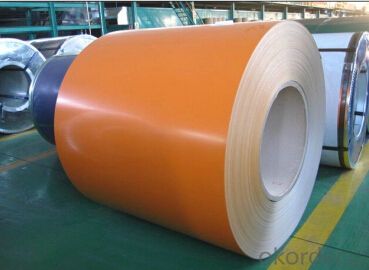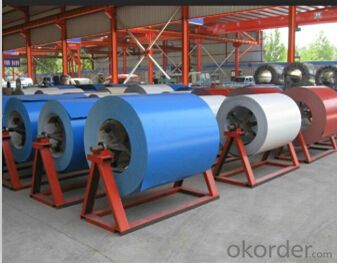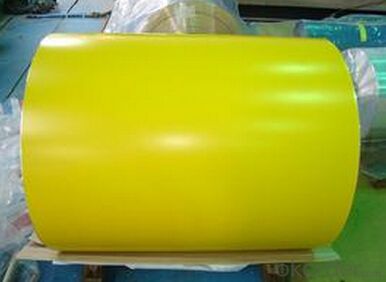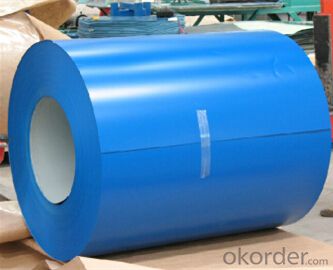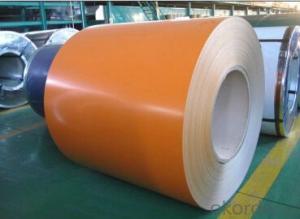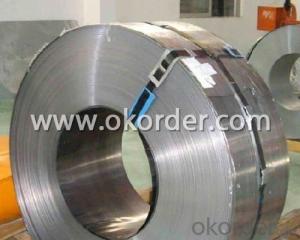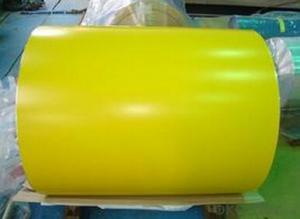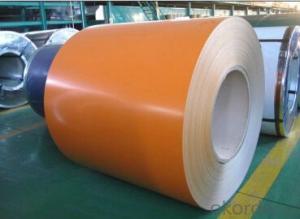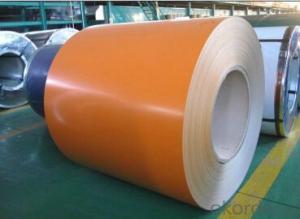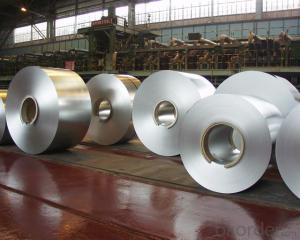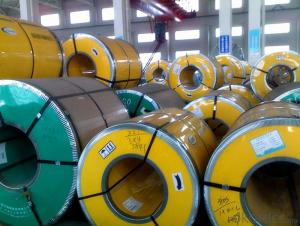Chinese Best Prepainted Galvanized steel Coil ASTM 615
- Loading Port:
- Tianjin
- Payment Terms:
- TT OR LC
- Min Order Qty:
- 26 m.t.
- Supply Capability:
- 22222 m.t./month
OKorder Service Pledge
OKorder Financial Service
You Might Also Like
1.Structure of Prepainted Galvanized steel Coil :
With Gi as base metal,after pretreatmet (degrease and chemical treatment) and liquid dope with several Layers of color,then after firing and cooling,finally the plate steel is called pre-painted galvanized steel ( PPGI) .Pre-painted galvanized steel is good capable of decoration ,molding,corrosion resistance
2.Main Features of Prepainted Galvanized steel Coil:
• Excellent process capability
• Smooth and flat surface
• Workability, durability
• Excellent heat resistance performance
• High strength
• Good formability
• Good visual effect
3.Prepainted Galvanized steel Coil Images

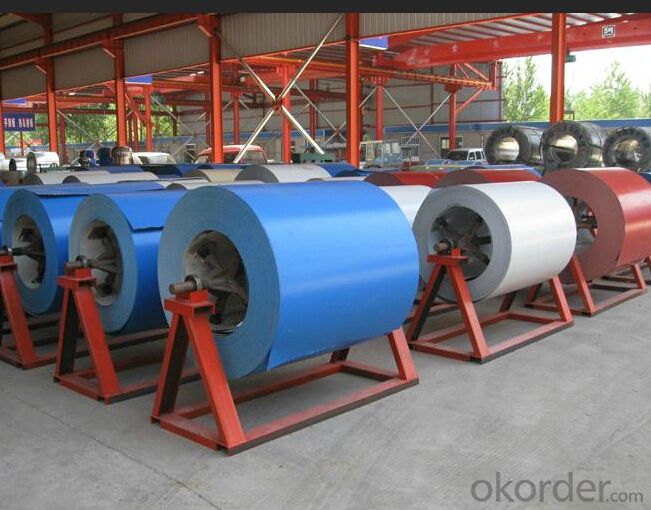

4.Prepainted Galvanized steel Coil Specification
Standard:ASTM, GB,JIS,JIS G3302 ASTM 755 EN10169
Grade: DX51D CGCC CS
Thickness: 0.13mm~3.0mm,
Width: 1250,600-1250mm
Coil weight:3-12 MT
Coil ID:508/610mm
Chemical composition:
C | Si | Mn | Cr | Ni | P | S |
0.150 | 0.476 | 11.231 | 12.50 | 0.900 | 0.039 | 0.010
|
5.FAQ of Prepainted Galvanized steel Coi
We have organized several common questions for our clients,may help you sincerely:
1.How do you control your quality
We have established the international advanced quality management system,every link from raw material to final product we have strict quality test;We resolutely put an end to unqualified products flowing into the market. At the same time, we will provide necessary follow-up service assurance.
2.how long we will receive the goods ?
After receiving your deposit or workable lc ,our normal shipment date is 15-20days,and it takes around 28 days to reach your port of destination. But is up to different destination
3. what is your moq
Normally our moq is 25per size ,but it is up to different size
- Q: What is the cost of steel strips?
- The cost of steel strips can vary significantly depending on various factors such as the type of steel, dimensions, quality, market conditions, and supplier. It is important to note that steel strips are available in a wide range of grades and finishes, each with its own price range. Additionally, the quantity being purchased can also impact the overall cost. To obtain an accurate cost, it is recommended to contact steel suppliers or manufacturers directly to inquire about the specific type of steel strips needed. They can provide pricing information based on the desired specifications and current market rates.
- Q: How are steel strips processed for surface coating?
- The surface coating of steel strips involves a series of steps to guarantee the adhesion and durability of the coating. Typically, the process includes cleaning, pre-treatment, and the application of the coating. To begin with, the steel strips undergo a thorough cleaning process to eliminate any dirt, grease, or contaminants that could hinder adhesion. This is usually accomplished using mechanical cleaning techniques like brushing or blasting, as well as chemical cleaning methods involving solvents or alkaline cleaners. Following the cleaning process, the steel strips are subjected to pre-treatment to enhance the bond between the surface and the coating. This can be achieved through various methods such as phosphating, chromating, or zirconium-based treatments. These treatments create a thin layer on the surface, enhancing adhesion and resistance to corrosion. Once the pre-treatment is completed, the steel strips are ready to receive the coating. The coating can be applied using different techniques such as hot-dip galvanizing, electroplating, or powder coating. The selection of the technique depends on the specific requirements of the steel strips. In hot-dip galvanizing, the steel strips are immersed in a bath of molten zinc, which forms a protective layer on the surface. Electroplating involves passing an electric current through the steel strip while it is immersed in a plating solution, resulting in the deposition of a metal coating like chrome or nickel on the surface. Powder coating, on the other hand, consists of electrostatically spraying a dry powder onto the steel strip and then curing it through heat. This process results in a durable and visually appealing finish. Once the coating is applied, the steel strips undergo quality control inspections. This may include visual checks, measurement of thickness, adhesion testing, and other assessments to ensure that the coating meets the required specifications. In conclusion, the process of surface coating for steel strips involves cleaning, pre-treatment, and application of the coating. This guarantees proper adhesion and ensures that the coating meets the desired standards for protection and appearance.
- Q: What is the tensile strength of galvanized steel strips?
- The tensile strength of galvanized steel strips can vary depending on the specific grade and thickness of the strips. However, typically, galvanized steel strips have a tensile strength ranging from 370 to 500 megapascals (MPa).
- Q: What are the different surface finishing methods for steel strips?
- There are several different surface finishing methods available for steel strips, each offering unique benefits and characteristics. 1. Hot-dip galvanizing: This is a popular method where the steel strip is immersed in a bath of molten zinc. The zinc coating provides excellent corrosion resistance and protects the steel from the elements. 2. Electroplating: In this method, a thin layer of metal is deposited onto the steel strip through electrolysis. Common metals used for electroplating include chromium, nickel, and zinc. Electroplating enhances the appearance of the strip and provides added protection against corrosion. 3. Powder coating: This process involves applying a dry powder onto the steel strip, which is then baked in an oven. The heat causes the powder to melt and form a durable and attractive coating. Powder coating offers excellent corrosion resistance and can be customized in various colors and finishes. 4. Painting: Steel strips can be painted using different types of coatings, such as epoxy, polyurethane, or enamel. The paint provides aesthetic appeal and also acts as a barrier against corrosion and weathering. 5. Passivation: This method involves treating the steel strip with a passivating agent to remove any contaminants and create a protective oxide layer on the surface. Passivation improves the resistance of the steel against rust and corrosion. 6. Anodizing: Typically used for aluminum, anodizing can also be applied to steel strips. In this process, the strip is treated with an electrolyte, causing a controlled oxidation to occur on the surface. Anodizing provides a durable and corrosion-resistant finish. 7. Mechanical finishing: This method involves mechanically altering the surface of the steel strip to achieve the desired finish. Examples include grinding, polishing, brushing, or shot blasting. Mechanical finishing can enhance the appearance of the strip and also improve its surface smoothness. By utilizing these different surface finishing methods, steel strips can be effectively protected against corrosion, improved in appearance, and tailored to meet specific application requirements. The choice of finishing method depends on factors such as the intended use of the strip, desired aesthetics, and environmental conditions it will be exposed to.
- Q: How do steel strips perform in terms of electrical conductivity?
- Steel strips have relatively low electrical conductivity compared to metals like copper or aluminum.
- Q: What is the cost range of steel strips?
- The cost range of steel strips can vary depending on various factors such as the thickness, width, length, and grade of the steel. Generally, the price of steel strips can range from $0.50 to $3.00 per pound. However, it is important to note that this is just a rough estimate and prices can significantly fluctuate based on market conditions, supplier, and quantity. It is recommended to contact steel suppliers or manufacturers directly to get accurate and up-to-date pricing information.
- Q: How are steel strips used in the shipbuilding industry?
- Steel strips are used in the shipbuilding industry for various purposes such as constructing the hull, reinforcing structural components, and creating interior fittings. They are shaped and welded together to form the framework of the ship, providing strength, stability, and durability to withstand the harsh marine environment. Additionally, steel strips are used for fabricating decks, bulkheads, and other essential parts of the ship, ensuring its overall structural integrity.
- Q: How are steel strips tested for quality?
- Steel strips are tested for quality through various methods such as visual inspection, mechanical tests, and chemical analysis. Visual inspection involves checking for any surface defects, such as cracks or imperfections. Mechanical tests, such as tensile and hardness tests, evaluate the strength and durability of the steel. Chemical analysis involves determining the composition of the steel, ensuring it meets the required specifications. These comprehensive tests ensure that steel strips meet the desired quality standards before being used in various applications.
- Q: How do steel strips perform in electromagnetic shielding?
- Steel strips are a highly effective material for electromagnetic shielding due to their low electrical conductivity and high magnetic permeability. They effectively block and divert electromagnetic waves, minimizing the transmission of electromagnetic interference (EMI) and reducing the risk of signal interference or compromise in sensitive electronic devices.
- Q: How are steel strips processed for crimping?
- Steel strips are processed for crimping by first being cleaned and prepared to remove any dirt or contaminants. They are then fed through a crimping machine, which applies pressure and shapes the strips into the desired crimped pattern. This process may involve multiple passes through the machine, depending on the specific requirements. Finally, the crimped steel strips are inspected for quality and can be further treated or coated if needed.
Send your message to us
Chinese Best Prepainted Galvanized steel Coil ASTM 615
- Loading Port:
- Tianjin
- Payment Terms:
- TT OR LC
- Min Order Qty:
- 26 m.t.
- Supply Capability:
- 22222 m.t./month
OKorder Service Pledge
OKorder Financial Service
Similar products
Hot products
Hot Searches
Related keywords
